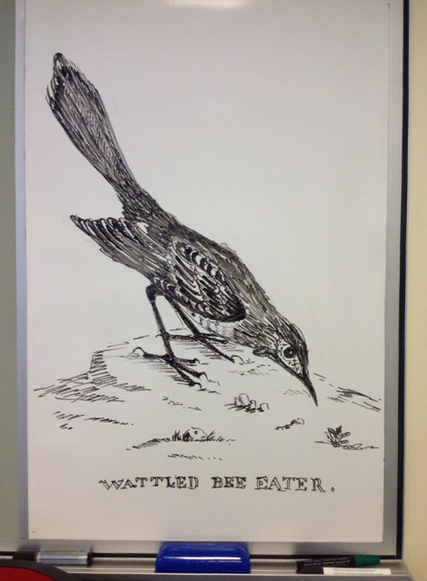About the Whiteboard project

Wattled bee eater [Red wattled bird], after S. Edwards, 1789
I am currently undertaking the Jane Nicholas Staff Fellowship. The topic of my fellowship is " A Natural History of the State Library of Victoria: a personal discovery and visual document of a Victorian icon". In the course of my project I have been studying a truly wonderful assortment of natural history resources from the 18th & 19th century, held in the Heritage Collections.
You can follow the progress of the Whiteboard project here.
In the spirit of the early naturalists/artists, I decided to share some of my discoveries with colleagues from all corners of the Library, in a creative experiment. I emailed everyone, asking for blank whiteboard spaces around the building that I could use to create drawings of native flora and fauna, based on images found in historical sources.
These will be temporary works that are drawn on-the-spot, with whiteboard markers. The drawings vary from naive to realistic, simple to complex, incorporating a range of voices from amateur to scientist, including my own. They are then left for staff to enjoy. They may last a few hours, days or even weeks - and, one by one, they will all be erased (as the whiteboard is required). I will try to do a drawing for everyone who has requested one (the response has been wonderful!) but I will start with one per section for the first round and then see how I am going for time.
The drawings are based on images in the collection. They form part of a chain of reproduction and transmission of knowledge. Part of my intent is to reanimate the original experience of observation by rendering these images in the very foreign context and medium of the office whiteboard. Another part is homage to these talented and dedicated artists from our past, and admiration for the beauty and comprehension of their art.
Once a drawing is completed I am hoping to get feedback on what happens to them next. For example, do people still write notes around it , did a bit get rubbed out or changed, have people responded to it, does it remind them of anything, what date did it get wiped out? (I want to record the life spans of the images as part of the project). A few photos would be great. These are just suggestions, and people may not get around to it, but it's part of the experiment. The drawings are however, first and foremost, a gift. There will be big ones and little ones, birds, beetles, fish, flowers and quadrupeds. I hope everyone has fun discovering them around the library.
November, 2012
You can follow the progress of the Whiteboard project here.
In the spirit of the early naturalists/artists, I decided to share some of my discoveries with colleagues from all corners of the Library, in a creative experiment. I emailed everyone, asking for blank whiteboard spaces around the building that I could use to create drawings of native flora and fauna, based on images found in historical sources.
These will be temporary works that are drawn on-the-spot, with whiteboard markers. The drawings vary from naive to realistic, simple to complex, incorporating a range of voices from amateur to scientist, including my own. They are then left for staff to enjoy. They may last a few hours, days or even weeks - and, one by one, they will all be erased (as the whiteboard is required). I will try to do a drawing for everyone who has requested one (the response has been wonderful!) but I will start with one per section for the first round and then see how I am going for time.
The drawings are based on images in the collection. They form part of a chain of reproduction and transmission of knowledge. Part of my intent is to reanimate the original experience of observation by rendering these images in the very foreign context and medium of the office whiteboard. Another part is homage to these talented and dedicated artists from our past, and admiration for the beauty and comprehension of their art.
Once a drawing is completed I am hoping to get feedback on what happens to them next. For example, do people still write notes around it , did a bit get rubbed out or changed, have people responded to it, does it remind them of anything, what date did it get wiped out? (I want to record the life spans of the images as part of the project). A few photos would be great. These are just suggestions, and people may not get around to it, but it's part of the experiment. The drawings are however, first and foremost, a gift. There will be big ones and little ones, birds, beetles, fish, flowers and quadrupeds. I hope everyone has fun discovering them around the library.
November, 2012